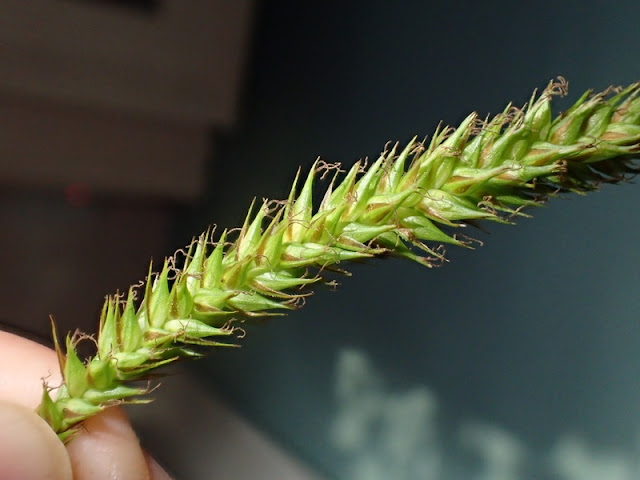 |
| On 15th June we set off for Bank Cabin Wood, via the road to Harewell Hall. |
 |
| Passing a wall with Klebsormidium crenulatum on the way |
Then we progressed down through the bracken to the stream. Here was woodland on wet acid soil - Alder and possibly Grey Willow.
Then we found a BIG sedge.
This is one of the participants scratching her head. I two was scratching mine.
It was big. Not big enough for Carex pendula.
Not red enough at the leaf tips and based for Carex binervis, but awfully like it. Anyway Carex binervis grows on Heather moorland, and this place was rather too shady and damp for heather
Not shining yellow green enough for Carex vesicaria
 |
| Add caption |
 |
| It is a tall tuft, growing amongst the Luzula sylvatica. The male and female heads show up against the black trousers. |
It turned out to be Carex laevigata - growing in exactly the habitat it should - damp woodland.
 |
| Carex laevigata |
 |
| The sheaths and stems are much more sharply triangular than Carex binervis. Carex binervis does have a flat /tongue shaped tip of the inner-face of the sheath so is a bit similar this way. |
 |
| Carex laevigata has a long acute ligule, whereas C binervis has a short one. |
 |
| The dead leaves and scales at the base of the shoots are brown, not reddish orange as in C binervis |
 |
| Here is a view I took the following day. We were in the valley below the mast |
 |
| Mentha verticillata - Whorled Mint (A cross between Mentha aquatica and Mentha arvensis) |

 |
Scutellaria galericulata -
|
Finally an invertebrate -
 |
Eriophyes laevis a gall on alder leaves caused by a mite |
We had only tackled a tiny part of the site but had had a good day.
--I may write about the invasive plant Cotula alpina that I checked up on, "on the way home" later that day
The next day I would be going to Knaresborough to see the cave of St Robert....
No comments:
Post a Comment